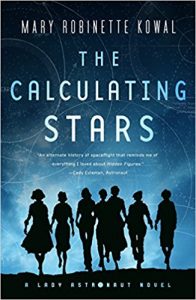Adrienne Martini reviews The Calculating Stars by Mary Robinette Kowal
 The Calculating Stars, Mary Robinette Kowal (Tor 978-0765378385, $15.99, 432pp, tp) July 2018.
The Calculating Stars, Mary Robinette Kowal (Tor 978-0765378385, $15.99, 432pp, tp) July 2018.
Mary Robinette Kowal was writing about midcentury female NASA workers before they hit the pop culture mainstream. While Hidden Figures – both book and movie – brought our collective attention to the women who worked as ‘‘calculators’’ at NASA, Kowal started noodling around with the idea in 2012. Her ‘‘The Lady Astronaut of Mars’’ started life as part of an audiobook project, then was published in written form on Tor.com.
In the novelette, we meet the Lady Astronaut in question, Elma York, already on Mars and nearing the end of her life. The Calculating Stars, the first of two books, takes us to the beginning of her space career. It opens in March 1952, moments before a comet crashes into the Eastern seaboard and changes everything. Elma and her husband Nathaniel had been enjoying a weekend of romance in the Poconos when the comet hit. They struggle to safety, learn about the devastation (and the likely deaths of the members of their families), and throw their grief into their government jobs. Both are highly placed in the equivalent of NASA. Given what the comet has done to the climate, which Elma has run the numbers on, the global conclusion is that getting off of the planet is humanity’s only choice if it wants to continue as a going concern. So how does Elma move from her role as a damn sharp calculator into one as the Lady Astronaut when she is fighting the considerable headwinds of being both female and Jewish in the 1950s? How does she respond when she realizes how many sharp minds are also being shoved to the side because of their race or gender? If you’re familiar with the novelette, you know that she eventually gets off of Earth. The Calculating Stars explains how.
So much about how Kowal structures Elma’s journey works, from her early days as a math whiz and the effect it had on her psyche, through her growth as a competent and confident professional. Equally lovely is the supportive and charming relationship between Nathaniel and Elma. You can’t help but root them both on. Sometimes, however, the story feels too much like a performance that ticks all of the boxes it needs to in order to advance the plot, without putting any emotion behind the action. The Calculating Stars occasionally feels like a preflight checklist, where we have to make sure we know about, say, Elma’s experience learning about the structure of racism and bias, just so the theme is adequately explored. It can feel manipulative rather than organically motivated.
Still, there are more scenes that fire on all cylinders than those that feel performative. The back third of The Calculating Stars is both intellectually and emotionally satisfying – and nicely sets up The Fated Sky, which is the second half of Elma’s story. Just one month after The Calculating Stars’ release, we’ll finally learn exactly how Elma got herself to Mars.
Adrienne Martini has been reading or writing about science fiction for decades and has had two non-fiction, non-genre books published by Simon and Schuster. She lives in Upstate New York with one husband, two kids, and one corgi. She also runs a lot.
This review and more like it in the June 2018 issue of Locus.
 While you are here, please take a moment to support Locus with a one-time or recurring donation. We rely on reader donations to keep the magazine and site going, and would like to keep the site paywall free, but WE NEED YOUR FINANCIAL SUPPORT to continue quality coverage of the science fiction and fantasy field.
While you are here, please take a moment to support Locus with a one-time or recurring donation. We rely on reader donations to keep the magazine and site going, and would like to keep the site paywall free, but WE NEED YOUR FINANCIAL SUPPORT to continue quality coverage of the science fiction and fantasy field.







